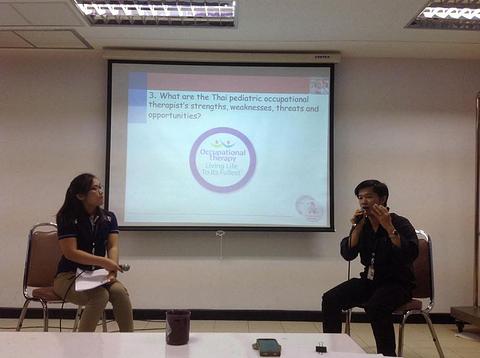ถอดบทเรียน สัมมนาหัวข้อพิเศษ "กิจกรรมบำบัดในผู้รับบริการฝ่ายเด็ก"
Hi everyone , I’m back to see you guys now because I have some special thing. In December 2013, I have the great opportunity to be in class of seminar from Dr.Kannika Permpoonpattana who have many experiences about Occupational Therapy in pediatric field work.
สวัสดีค่ะทุกคน กลับมาพบกันอีกครั้งในเรื่องเกี่ยวกับกิจกรรมบำบัดค่ะ พอดีว่าเมื่อเดือนธันวาคมที่ผ่านมา ดิฉันได้มีโอกาสได้เข้าฟังการสัมมนาของอาจารย์ทางกิจกรรมบำบัดในหัวข้อพิเศษเรื่อง “กิจกรรมบำบัดในผู้ป่วยฝ่ายเด็ก” โดยอาจารย์ ดร.กันนิกา เพิ่มพูนพัฒนา อาจารย์สาขากิจกรรมบำบัด ผู้ซึ่งมีความเชี่ยวชาญในการให้บริการทางกิจกรรมบำบัดในผู้รับบริการฝ่ายเด็กค่ะ
And this is my knowledge translation from that special seminar class.
และต่อจากนี้จะเป็นการถอดบทเรียนจากการสัมมนาในครั้งนี้ค่ะ
1. What is the key mission of Occupational Therapy in Pediatric?
หน้าที่หลักของงานกิจกรรมบำบัดในฝ่ายเด็ก คืออะไร?
Right now , OT in pediatric field mainly work with children’s development but in the future should mention in both normal and abnormal child. In normal child should be a health promotion. For the abnormal child should be a rehabilitation to get them going to like nearly the normal development.
ในปัจจุบัน งานกิจกรรมบำบัดในผู้รับบริการฝ่ายเด็กมักจะเน้นไปในเรื่องของพัฒนาการของเด็กที่มีความผิดปกติ แต่ในอนาคตหากเป็นไปได้ เราควรดูแลครอบคลุมทั้งเด็กทั่วไปและเด็กมีที่ผิดปกติ ให้การส่งเสริมสุขภาพหรือพัฒนาการที่ดีในเด็กปกติ และในเด็กที่มีความผิดปกติก็จะเน้นการบำบัด ฟื้นฟูให้เด็กคนนั้นมีพัฒนาการใกล้เคียงกับพัฒนาการปกติมากที่สุด
2. How does the OTs ensure quality of intervention for pediatric clients?
นักกิจกรรมบำบัดจะมั่นใจในคุณภาพการรักษาในผู้รับบริการฝ่ายเด็กได้อย่างไร?
Normally after I met the children in the first time. I evaluate them, then make a problem list, and set the goal. After that I create the activity for that goal and for the improvement , we check the improvement of the child by their performance. For example, they can go to the school, learn, or living independently in their home. After finished the class, the smile of children is the achievement of my treatment.
โดยปกติแล้วหลังจากที่ได้พบเด็กที่ครั้งแรกที่เจอกันแล้ว จะมีการประเมินและแจกแจงปัญหาของเด็กที่พบ จากนั้นก็จะทำการตั้งเป้าประสงค์การรักษา แล้วก็จะเลือก/สร้างกิจกรรมที่ตรงตามเป้าประสงค์ที่วางไว้ ส่วนความก้าวหน้าทางการรักษาจะดูได้จากระดับความสามารถของเด็ก เช่น สามารถไปโรงเรียน นั่งเรียนได้ หรือใช้ชีวิตประจำวันด้วยตนเองได้ นอกจากนี้ รอยยิ้มของเด็กก็ถือเป็นความสำเร็จในการรักษาได้อย่างหนึ่ง
3. What are the Thai OTs in pediatric’s strengths, weakness, threats and opportunities?
จุดแข็ง จุดอ่อน สิ่งที่เป็นภัยหรือโอกาสของนักกิจกรรมบำบัดในฝ่ายเด็กคืออะไร?
We have a small number of occupational therapist that can help the child. In my opinion we can help one child with one OTs but we have 10 child. For me I choose only 3-5 child/day and treat one by one to make them get high potency to improvement. For the future we have to produce more OTs to serve the client and OTs should change the idea of parent that shouldn’t depend on OTs to make their children to get the improvement.
นักกิจกรรมบำบัดที่จะสามารถช่วยเหลือเด็กยังมีจำนวนน้อย ซึ่งฉันคิดว่านักกิจกรรมบำบัดหนึ่งคนจะสามารถช่วยเหลือดูแลเด็กได้หนึ่งคน แต่ในความจริงแล้วนักกิจกรรมบำบัด1คนต้องดูแลเด็กถึง10คน ฉันจะดูเด็กแบบตัวต่อตัววันละประมาณ 3-5 คน ซึ่งเด็กจะได้รับการรักษาที่ดีและมีโอกาสที่จะเห็นพัฒนาการได้มากกว่า ในอนาคตอยากให้มีการผลิตนักกิจกรรมบำบัดเพิ่มขึ้นเพื่อรองรับกับจำนวนผู้รับบริการที่มีมาก และนักกิจกรรมบำบัดควรเปลี่ยนความคิดของผู้ปกครองที่ว่าความก้าวหน้าหรือพัฒนาการของลูกนั้นต้องขึ้นอยู่กับนักกิจกรรมบำบัดเพียงอย่างเดียว
4. What strategies are being used of OTs in pediatric? How have these succeeded?
กลยุทธ์ที่ใช้ในกิจกรรมบำบัดในผู้รับบริการฝ่ายเด็กมีอะไรบ้าง? และทำให้สำเร็จได้อย่างไร?
We have learn already for theory, model or frame of reference. You should combine and adapt for individualize program that appropriate to the client because every FoR or model is study from the human and every kind of our clients
นักกิจกรรมบำบัดทุกคนล้วนได้เรียนรู้ในทฤษฎี โมเดลและกรอบอ้างอิงต่างๆมาแล้วทั้งสิ้น เราควรนำความรู้เหล่านั้นมาใช้ร่วมกันและปรับให้เหมาะสมกับผู้รับบริการแต่ละคนเพราะทฤษฎีต่างๆเหล่านั้นก็ล้วนมาจากการศึกษามนุษย์ผู้ซึ่งเป็นผู้รับบริการของเรานั่นเอง
5. What have you learned about CMU-OT leading to build/create MU-OT?
คุณได้เรียนรู้อะไรจากกิจกรรมบำบัด มหาวิทยาเชียงใหม่ที่สามารถนำมาสร้างหรือพัฒนากิจกรรมบำบัดที่ มหาวิทยาลัยมหิดลได้บ้าง?
Maybe better that I will talk what I have learn in neuroscience. You can learn it after you graduated OT. Our brain have the property to adapt and apply. For example, we study OT that learns How to adapt How to apply How to grade How to solve the problem?. When you study in neuroscience you have many problem to solve and we will have the strategies to solve them
ขอพูดถึงการเรียนเกี่ยวกับประสาทวิทยาซึ่งเมื่อเรียนจบทางกิจกรรมบำบัดแล้วเราสามารถเรียนด้านนี้ต่อได้ เป็นการศึกษาว่าสมองของเราสามารถปรับประยุกต์สิ่งต่างๆได้ เช่น ในการเรียนกิจกรรมบำบัดต้องเรียนเกี่ยวกับการปรับ ประยุกต์รวมถึงการแก้ปัญหาต่างๆ ซึ่งในการเรียนด้านประสาทวิทยาจะทำให้เรารู้กลยุทธ์ที่ช่วยในการปรับประยุกต์ และแก้ปัญหาได้ดีขึ้น
6. What do you see in the future as an OTs in pediatric and how is this led to success?
ในฐานะนักกิจกรรมบำบัดฝ่ายเด็ก คุณเห็นอะไรที่เกี่ยวกับกิจกรรมบำบัดในอนาคตบ้างและจะไปสู่ความสำเร็จนั้นได้อย่างไร?
I want to see OT in every hospital in school and in community. OT should work like go to their home to advice not like on the present day that we stay in the hospital and the children come to treat only 1 hour and the go back
ฉันอยากจะเห็นว่าเรามีนักกิจกรรมบำบัดในทุกๆโรงพยาบาล ในโรงเรียน รวมถึงในชุมชน นักกิจกรรมบำบัดควรทำงานในเชิงรุกโดยไปให้คำแนะนำตามบ้านที่ไม่เหมือนกับในปัจจุบันที่เด็กจะเดินเข้ามาหานักกิจกรรมบำบัดตามรพ.เพื่อรับการรักษาเพียง 1 ชม.เมื่อเสร็จก็แยกย้ายกลับบ้านไป
special thanks Dr. Kannika for any information and experiences and Dr. Anuchart for the best moderator!!
ขอบขอบคุณข้อมูลและประสบการณ์ดีๆจากอาจารย์ ดร.กันนิกา และ ผู้ดำเนินรายการยอดเยี่ยม : อาจายร์ ดร. อนุชาติค่ะ
ความเห็น (0)
ไม่มีความเห็น
